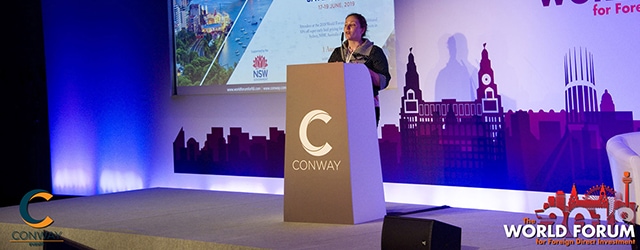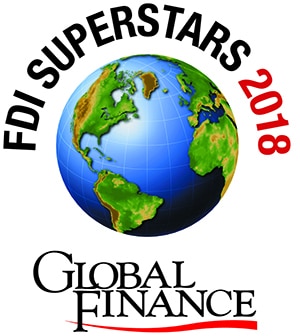With direct investment retreating from the US and the UK, a crop of smaller countries, topped by Singapore, were the biggest winners in the FDI horse race. Global Finance offers a new analysis and ranking.

The shadow of Brexit, which is impacting many multinationals, fell over Britain during the past year and drove many changes among the top nations in the Global Finance FDI Superstars ranking. Britain, last year’s No. 1, fell out of the top 20 entirely, while Ireland took some of its business and moved up to No. 2.
Singapore, one of the main commercial and financial gateways between Asia and the rest of the world (despite its size) and last year’s No. 2, slid into the top spot.
In addition to Brexit, political tensions and crumbling international trade relations contributed to a 23% decline in global flows last year, when the UK was No. 1 and the US took 13th place. This year, both disappeared from the top 20. Rising protectionism and uncertainty about US tax, trade and investment policies under the Trump administration have taken a toll. According to the United Nations Conference on Trade and Development (UNCTAD), FDI’s global decline can also be attributed in part to a 22% decrease in the value of cross-border mergers and acquisitions—even discounting the deals that inflated 2016 figures, the decrease remains significant.
The biggest story of the past year has not been the winners but the losers. The latest Republican tax reform in the US is currently driving an even bigger dip in global FDI, according to UNCTAD’s data for the first half of 2018. As American companies repatriated funds from their affiliates abroad, their reinvested earnings from abroad plummeted from $147 billion last year to negative $247 billion this year, taking world FDI flows down by a staggering 41%.
Europe appears to be taking the worst hit, with Ireland and Switzerland the region’s most affected locations. UNCTAD officials fear a further contraction of global FDI could impact global value chains and trade. Cross-border M&A remains stable, but the only upside in the latest data is a rising number of greenfield projects after a poor 2017.
FDI in the UK suffered a devastating 92% drop in 2017, to just $15 billion, accounting for more than 40% of the global decrease. To be sure, the previous year’s figures were overblown by a few large M&A deals; but even discounting for this anomaly, UK results this past year were so poor that one must go back to 1994 to find lower FDI inflows. The first half of 2018 has seen a recovery, with increased intrafirm loans upping inward flows to $66 billion.
Across the Atlantic, inward FDI flows fell by a less-dramatic but still substantial 40% in 2017. While the US remained the first destination for FDI, policy uncertainty, deeper scrutiny of investments, tariff wars and the administration’s stance on trade led international investors to curb their enthusiasm, and for the first half of 2018, the US fell to third place. Reduced corporate tax rates and full expensing of investment should help attract FDI, but foreign investors don’t seem to be very eager. After some improvement in the first quarter of 2018, in the second quarter the US saw a net outflow. Chinese investors are facing new restrictions from their own government, and Trump’s increasingly antagonistic stance toward Beijing is driving most of them toward Europe. Sweden, the UK, Germany and France were the top destinations for Chinese investment in the first half of 2018, according to Baker McKenzie.
Superstars: Strong and Agile
Those at the top of our core FDI Superstars ranking this year posted solid inflows, improved in their relative position in international markets, delivered economic and political stability, and have created an investor-friendly environment that enabled them to climb the rankings despite strong headwinds.
#1 | SINGAPORE
Singapore is an FDI wonder. Less than half the size of London and without any natural resources, the city-state’s economic openness, business-friendly institutions, educational attainment, well-developed financial-services sector, and political stability have made it a magnet for overseas investment. Even after a decline of almost 20% in incoming FDI last year, Singapore was the fifth-largest recipient, attracting a share of FDI more than 11 times its share of world GDP. It has risen 62 positions in the FDI Performance ranking over the last decade. Prospects for 2018 look strong again, according to UNCTAD, even though US multinational companies divested $34 billion.
#2 | IRELAND
Ireland climbs two positions in our Superstars ranking this year, doubling last year’s figures. Ireland’s growth forecast is significantly higher than for most of the EU. Yet its favorable tax system, well-educated workforce, and access to the EU common market may not be enough to keep the FDI machine going in 2018. Since many American companies started repatriating earnings following the passage of a major tax-cut bill there, inflows to Ireland have taken a nosedive. According to UNCTAD, FDI in Ireland was down $81 billion in the first half of 2018.

Breda O’Sullivan, manager of corporate strategy and planning at IDA, the Irish investment promotion agency, says the IDA secured 237 new investments. Brexit has been a factor behind more than 40 companies adding or expanding in Ireland, according to the IDA. Technology, financial services, and pharmaceuticals were particularly favored, with companies such as Abbvie, Xilinx, Stats, Huawei, Stripe, Pilz, Sojern and SentryOne have relocated or expanded activities on Irish soil.
#3 | THE NETHERLANDS
After a post-crash record in 2016, the Netherlands saw FDI tumble more than 30% last year. Still, in the context of a global FDI contraction, it held on in third place. The FDI climate in the Netherlands is gaining strength, due to “its infrastructure, the workforce’s education and language skills, the fiscal climate and its pivotal location in Western Europe,” says Hugo Peek, CEO of EMEA, corporate and institutional banking at ABN AMRO. “Liquid capital markets and the available skilled workforce are benefitting technology—in particular, fintech and medtech—and logistics, especially warehousing and retail distribution.”
The Netherlands is attracting a noticeable number of Brexiting firms in the trading business. The European Medicines Agency, for instance, is moving to Amsterdam in 2019; and many companies in the pharmaceutical and health sciences sectors are expected to move some operations to be close to the agency.
However, “With low unemployment rates, high occupancy rates in offices and rising house prices, it is not getting easier to establish oneself in the Netherlands,” says Peek. Since the UK is the country’s third-largest trading partner, Peek suggests that a hard Brexit might also have some negative impact “on logistical hubs such as the Port of Rotterdam and the maritime industry in general, as well as on fruit, vegetables and fishing exports.”
#4 | SWITZERLAND
Switzerland, which didn’t even make the list last year, vaults to No. 4. The confederation has traditionally been attractive to FDI, thanks to its economic and political stability, favorable tax laws, business-friendly regulations, world-class infrastructure and highly developed financial system. Cantonal administrations offer significant tax incentives that add to the country’s enticements. Nevertheless, FDI in Switzerland has been very volatile, due to the country’s role in indirect-financing practices by multinational. As a result, Switzerland, along with Ireland, has been one of the countries most impacted by US corporations’ repatriation of funds in the first half of 2018, with US FDI in the country dropping by around $31 billion according to UNCTAD—making its performance even more impressive.
#5 | PORTUGAL
Portugal advances to fifth place. Parallel to the country’s broader economic recovery, the last three years have seen a sustained recovery in FDI despite the global dropoff. While Portuguese GDP has still not rebounded to pre-2008-crisis levels, the country’s evolution is sometimes called the Portuguese “miracle.” Export revenues are expanding, driven by tourism but also by goods exports. Investment is growing in machinery, especially equipment, and software. Demand for durable goods is growing and the national unemployment rate is slightly below the EU average.
The government, additionally, is finding more-direct ways to encourage FDI. The Golden Visa residency-by-investment program and tax exemptions for new residents who invest in the country have significantly improved Portugal’s attractiveness for FDI, not only for non-EU residents but for an increasing number of EU retirees looking for low taxes and a high quality of life.
According to the European Parliamentary Research Service, between 2013 and 2018, up to 9% of first-time residency permits were granted through this program. Foreign money, along with reform of the law governing property rentals, created the conditions for a boom in the real estate market. Portugal isn’t the only country that offers such visas; its tax exemptions, attractive cities, and qualified and relatively cheap labor have further made it attractive to tech startups.
#6 | CYPRUS
Cyprus advances two positions in this year’s ranking to sixth place. Because Cyprus has become a strong intermediation hub, inbound FDI has been quite volatile; but in the last few years, it seems to have steadied. In 2017, Cyprus raised a share of global investment equal to some 17 times its share of world GDP. The Cypriot economy seems to be recovering from 2008, public debt appears to be on the mend, and almost all sectors of the economy are showing positive growth, with tourism in the lead.
“This is the easternmost jurisdiction of the EU, in an area of unstable, non-EU countries; and that is very appealing for companies wanting to access [Middle East and North African] markets but also gain a foothold in the EU,” Natasa Pilides, deputy minister of shipping and former director general of promotion agency Invest Cyprus, told Global Finance in February.
Cyprus’s Citizenship by Investment program was modified right after the country’s banking bailout in 2013 to make it more enticing—it is the fastest route to an EU passport, requiring just three months and €2 million. Reforms enacted in 2015 made the tax system even less burdensome for high-net-worth individuals seeking EU citizenship through investment. Since then, FDI has grown more rapidly, but the EU has put visa and citizenship programs under scrutiny—Cyprus being one of the most harshly criticized. The Cypriot Fiscal Council has also shown disapproval, warning that continued reliance on the program might divert resources from productive sectors of the economy. The government recently announced that it will increase vetting of investors and limit the number of passports granted to 700 per year.
#7 | CZECH REPUBLIC
The Czech Republic leaps 15 steps in this year’s Superstars ranking, from 22nd last year to 7th position this year, despite the 24% dip in FDI after hitting a post-crash record in 2016. One cause was the cooling of the M&A scene after four very strong years, prompting a drop in the number of transactions and a small negative net result. This meant the value of acquisitions by foreigners was slightly overmatched by foreign divestments in Czech companies.
Nevertheless, the Czech Republic was the largest recipient of FDI in Central Europe this year, outstripping Poland. The economy is posting strong growth and a low unemployment rate. The banking system looks healthy, while a strong industrial sector is another a strong selling point. Investors in the country benefit from moderate labor costs, an educated workforce largely competent in English and also in German, a good standard of living, reliable infrastructure, a central position in Europe and high social stability. Despite losing three positions last year, the country’s rank in the Ease of Doing Business index rose to 30th in 2017—just four years ago it was 75th.
#8 | HONG KONG
Inflows were down by 11% this year, yet Hong Kong gained three positions in our ranking. M&A has helped: Although the number of transactions has decreased, the net value of deals for Hong Kong companies more than doubled in 2017, accounting for almost one fifth of FDI flows into the country. Many of these deals involved Mainland Chinese firms buying into Hong Kong’s real estate and insurance sectors.
Like some other countries in our list, Hong Kong has overcome the disadvantage of a small domestic market, winning an important position in the world’s trade and investment networks by providing top-notch financial, technological and logistical services. Hong Kong is the third-largest recipient of FDI in the world, trailing only the US and China, and also comes in third by FDI Performance, pulling a share of FDI more than 17 times its share of world GDP.
#9 | AUSTRALIA
Australia slid four places this year. While its performance—according to most of the indicators that factor into our index—is in the upper range, its economy is less entwined with global value chains and trade and investment networks than some competitors. It is physically far from the rest of the world. That adds up to a relatively poor FDI performance, with a weight in world FDI only 50% above its weight in world GDP.
Australian FDI flows dropped by $1.4 billion, or 3%, to $46.4 billion last year owing to a $2.8 billion decline in the net value of cross-border M&A deals. UNCTAD’s World Investment Report notes that UK-based global corporations took a good share of the blame as they disposed of Australian assets.
Nonetheless, Australia’s FDI stock kept growing at a good pace; and the many overseas investors in Australia continue to enjoy the advantages of one of the world’s most stable economies, now entering its 27th consecutive year of growth. Although US and EU investors own the bulk of Australia’s FDI stock, its ties with Asian countries are increasingly strong, with Chinese FDI growing at an average of 19% each year since 2011, according to Austrade. Other fast-growing investment sources are Singapore and Hong Kong, and, outside of Asia, Canada. According to Austrade data, the main targets for FDI in Australia are finance and insurance (41% of total assets), other services (31%), mining (17%) and manufacturing (11%).
#10 | AUSTRIA
After an extremely poor 2016, when it posted the worst results for FDI in the world, Austria is making a comeback this year, jumping to the 10th place of our ranking. Traditionally a solid destination, Austria’s take had been on a downward trend since 2013, reaching net divestment of $9 billion in 2016. Most of these assets were shed by investors in Italy (-$7.5 billion), the Netherlands (-$2.7 billion) and the US (-$2.6), while others including Germany ($1.5 billion), Russia ($1.3 billion) and Luxembourg ($1 billion) offered a modest counterbalance.
This year, Austria has turned the picture around, attracting $9.6 billion of net investments. The economy’s slow advance between 2012 and 2016 may have weighed on the country’s ability to attract FDI; but at 3% in 2017, GDP growth seems to have regained steam. Austria offers a fairly business-friendly environment, an advantageous location in the center of Europe with good infrastructure, a highly productive workforce and a high quality of life. However, Austria now faces competition from former Soviet Bloc countries—including for capital of Austrian institutions—and as in other European countries, the recent rise of populism may be weighing on its reputation for political stability.
#11—#20
Rounding out our top 20 are the increasingly diversified United Arab Emirates, followed by Malaysia, which continues its record of dependable growth. Right behind are Azerbaijan, which boasts investor-friendly policies and economic diversification. Generous regulations for FDI bring Panama to number 14. Increased cross-border M&A lift France to the 15th position and stable Ghana follows as the first African country to join the ranking. Israel, where the value of cross-border M&A almost quadrupled, follows. After a slump in 2016, Indonesia is recovering, landing it in 18th place. Germany follows, doubling on the previous year’s disappointing FDI figures, and Serbia, where ongoing reforms tied to its EU accession process and its June agreement with the International Monetary Fund appear to be bearing fruit, completes the list.
|
2017 Rank |
2018 Rank |
Country |
Total Score |
| 2 | 1 | Singapore | 110 |
| 4 | 2 | Ireland | 136 |
| 3 | 3 | Netherlands | 153 |
| – | 4 | Switzerland | 199 |
| 7 | 5 | Portugal | 309 |
| 8 | 6 | Cyprus | 320 |
| – | 7 | Czech Republic | 320 |
| 11 | 8 | Hong Kong, China | 321 |
| 5 | 9 | Australia | 324 |
| – | 10 | Austria | 367 |
| – | 11 | United Arab Emirates | 369 |
| 14 | 12 | Malaysia | 379 |
| 9 | 13 | Azerbaijan | 412 |
| 15 | 14 | Panama | 414 |
| – | 15 | France | 419 |
| 10 | 16 | Ghana | 420 |
| – | 17 | Israel | 425 |
| – | 18 | Indonesia | 447 |
| – | 19 | Germany | 450 |
| – | 20 | Serbia | 452 |
| – | 21 | Colombia | 461 |
| – | 22 | Georgia | 464 |
| 16 | 23 | Mozambique | 469 |
| – | 24 | Brazil | 473 |
| 19 | 25 | Viet Nam | 476 |
Rising Stars
They may not be the most powerful or the most efficient, but the Rising Stars are countries whose inflows improved the most over the past 10 years, boosting their positions in the FDI Performance ranking.
This is the list that shows the most variation year to year, as many of these countries have such small economies that relatively small variations in FDI can make a huge difference, and it’s the list most likely to show upstarts.
However, this year’s list is led by Ireland and the Netherlands, both relatively large economies and big recipients of FDI. That’s because both had extraordinarily negative FDI a decade ago, in 2008, resulting in a big rebound when they returned to normal growth. The other two European countries on the list are Portugal (15th) and Switzerland (17th). Switzerland, like Luxembourg last year, appears here due to the high volatility of its FDI flows.
Azerbaijan drops only one position to 3rd, thanks to the boost to FDI that followed the discovery of new oil and gas sources in the Azeri–Chirag–Gunashli and Shah Deniz fields. Sierra Leone, after a slump due to the Ebola epidemic, benefitted from a recovery in iron ore exports to quadruple the previous year’s FDI figures and rise from 10th to 4th place.
Ethiopia (5th) is the fastest-growing economy in Africa and the continent’s second largest magnet for FDI inflows in 2017 after Egypt. Despite political unrest, international investors are holding onto their bets. Global apparel firms are setting up factories there, and Chinese and Turkish companies announced plans to make light manufacturing and automotive investments after the government lifted a state of emergency in August 2017.
Some countries, mostly African, also have natural resources to thank for increased FDI flows in their economies. Often, these countries are recovering from periods of conflict or high instability, or from authoritarian regimes, or from natural disasters that had kept growth and investments at minimal levels.
And of course, there’s Singapore, one of the FDI elite that took a hit during the 2008 crisis but has since rebounded impressively.
|
2017 Rank |
2018 Rank |
Country |
Improvement Score (Positions Escalated) |
| – | 1 | Ireland | 165 |
| – | 2 | Netherlands | 154 |
| 2 | 3 | Azerbainjan | 147 |
| 10 | 4 | Sierra Leone | 126 |
| 8 | 5 | Ethiopia | 121 |
| – | 6 | Haiti | 113 |
| – | 7 | Palau | 107 |
| – | 8 | Somalia | 104 |
| – | 9 | Equatorial Guinea | 99 |
| 5 | 10 | Myanmar | 93 |
| – | 11 | Aruba | 92 |
| – | 12 | Burkina Faso | 89 |
| 7 | 13 | Togo | 85 |
| 19 | 14 | Philippines | 79 |
| 14 | 15 | Portugal | 74 |
| 6 | 16 | Mozambique | 72 |
| – | 17 | Switzerland | 72 |
| – | 18 | Rwanda | 71 |
| – | 19 | Cameroon | 67 |
| – | 20 | Singapore | 62 |
The Outperformers
While Giants get the most FDI, which countries get more FDI than their markets would warrant? We measure the most efficient FDI magnets by comparing the proportion of FDI a country attracts to its proportion of global GDP.
A country producing just 2% of global GDP but attracting 8% of global FDI is punching above its weight, an outperformer. Outperformers tend to be either richly endowed with natural resources or financial hubs built on loose regulations.
Small island nations with generous tax laws and hyperdeveloped financial systems once again make up a substantial share of the list. The British Virgin Islands and the Cayman Islands stayed on top this year, galaxies ahead of the other top performers with global FDI weightings that vastly outpace their weights in world GDP.
On the resource-rich side, Africa contributes to the Outperformers list. FDI flows follow natural resources, but also political and social stability and economic reform. Mozambique slid three positions to 9th this year; Sierra Leone, rose four positions to 10th; and Congo, tumbled five positions to 12th.
Somalia, excluded last year for lack of GDP data, jumped straight to 5th place, with a share of global FDI more than 15 times its share of world GDP. Relative stability following the nation’s long civil war allowed for the return of refugees and new investment. Conflict in the Arabian Peninsula has fueled the fight to control access to the Gulf of Aden, attracting significant investment to Somali ports.
Two new Asian countries join the Outperformers this year: Mongolia (13th) and Cambodia (16th). Mongolia’s mining sector is benefitting fromthe recovery of commodities prices, and 2017 also brought important investments in the energy sector. Chinese investments in infrastructure, industry and banking have steadily and significantly boosted FDI in Cambodia over the last 10 years. New Caledonia, strongly dependent on nickel, is down four places to 15th.
Georgia climbs two spaces to 17th. Ranking 6th on the World Bank’s most recent Ease of Doing Business index, Georgia is now one the most liberal and business-friendly focused-investment destinations in the Caucasus.
Low taxes, a welcoming business environment and a boost in real estate investment also earned Montenegro 18th place. This is the first time it has joined the list, making the mountainous republic the only European country to earn a spot this year aside from Malta and Cyprus.
|
2017 Rank |
2018 Rank |
Country |
FDI/GDP |
| 1 | 1 | British Virgin Islands | 2,232.26 |
| 2 | 2 | Cayman Islands | 526.53 |
| 5 | 3 | Hong Kong, China | 17.18 |
| 8 | 4 | Cyprus | 16.77 |
| – | 5 | Somalia | 15.19 |
| 4 | 6 | Malta | 14.67 |
| 9 | 7 | Singapore | 11.24 |
| 12 | 8 | Anguilla | 10.67 |
| 6 | 9 | Mozambique | 10.19 |
| 14 | 10 | Sierra Leone | 9.01 |
| – | 11 | Saint Kitts and Nevis | 7.64 |
| 7 | 12 | Congo | 7.58 |
| – | 13 | Mongolia | 7.57 |
| 20 | 14 | Seychelles | 7.26 |
| 11 | 15 | New Caledonia | 7.21 |
| – | 16 | Cambodia | 7.21 |
| 19 | 17 | Georgia | 6.91 |
| – | 18 | Montenegro | 6.47 |
| 15 | 19 | Maldives | 6.46 |
| – | 20 | Sao Tome and Principe | 6.17 |
The Giants
These Goliaths of FDI attract the most outside direct investment in absolute terms. While this ranking usually receives the most attention in the media, it favors size by three measures—GDP, population and area—over performance. The US, China, Germany, France, India, Brazil, Canada, Indonesia, Russia, Mexico and Australia all make the top 10 in at least one of these three measures—even though none qualifies as a Superstar.
Spain (19th) may not qualify as one of the giants, but is the 30th-largest country by population and ranks 14th by GDP. Some smaller jurisdictions, like the Netherlands, Hong Kong, Singapore, Switzerland, the British Virgin Islands, the Cayman Islands and Ireland, have overcome their size by building on other advantages. A strategic location, important ports, historical ties to regions on the other side of the globe or a strong tradition in trade are the cornerstones on which some of these have built solid economies that are very effective at attracting FDI. Many rely on low-tax regimes, privacy protections or business-friendly regulations. While international pressure has forced most of these countries to increase transparency in recent years, they still offer many regulatory advantages and sophisticated banking and financial sectors that have developed under the umbrella of those regulations.
Israel, which closes the top 20, doesn’t quite fit any of these patterns. It makes its first appearance in the top 20 this year, reaping $19 billion of FDI, an extraordinary increase of almost 60% over 2016’s record total. A big part of its success can be explained by a cross-border M&A frenzy, mostly in the pharma and tech sectors. The biggest deal was the acquisition of collision-avoidance systems specialist Mobileye by Intel for more than $15 billion, an extraordinary figure for the Israeli market. The pharmaceutical company TEVA has been selling parts of its business, raising $2.5 billion to repay part of the debt it took on to acquire drug maker Actavis Generics last year for $40 billion. According to a PwC Israel report, Israeli assets sold to foreign companies reached $6.6 billion, Mobileye excluded.
|
2017 Rank |
2018 Rank |
Country |
($ Mil.) |
| 1 | 1 | United States of America | 275,381.00 |
| 3 | 2 | China | 136,320.00 |
| 4 | 3 | Hong Kong, China | 104,332.98 |
| 7 | 4 | Brazil | 62,712.61 |
| 6 | 5 | Singapore | 62,005.97 |
| 5 | 6 | Netherlands | 57,956.67 |
| 16 | 7 | France | 49,794.91 |
| 9 | 8 | Australia | 46,367.98 |
| – | 9 | Switzerland | 40,986.08 |
| 11 | 10 | India | 39,916.09 |
| 7 | 11 | British Virgin Islands | 38,358.08 |
| 10 | 12 | Cayman Islands | 37,433.21 |
| – | 13 | Germany | 34,726.28 |
| 18 | 14 | Mexico | 29,695.01 |
| 19 | 15 | Ireland | 28,974.62 |
| 12 | 16 | Russian Federation | 25,284.03 |
| 13 | 17 | Canada | 24,243.75 |
| – | 18 | Indonesia | 23,063.11 |
| – | 19 | Spain | 19,086.15 |
| – | 20 | Israel | 18,954.00 |
METHODOLOGY
Global Finance studied various metrics in its efforts to identify the countries that are most successful at drawing foreign direct investment (FDI). Raw inflows favor size, so this measure alone yields a list of economic powerhouses (The Giants).
Our algorithm mitigates FDI’s notorious volatility, especially for smaller countries, by considering performance over a decade. Still, even over time, raw measures tend to push out smaller countries; so we calculate each country’s share of FDI relative to its share of world GDP. This yields a dramatically different portrait, heavily populated with offshore financial centers that attract financial capital disproportionate to their share of global economic activity (The Outperformers,). We also compared rankings of today with ten years ago, which yields a list of countries that have most dramatically improved their FDI competitiveness over the decade (Rising Stars). Our Superstars algorithm incorporates all these metrics.
Furthermore, to identify countries with the best overall mix of FDI enticements, we look not only at market size, natural resources and a robust labor force, but also smart policy—a nation’s active choices rather than its accidental benefits of geography. The algorithm thus also incorporates each country’s scores on the World Bank’s Ease of Doing Business index and on the Global Peace Index compiled by the Australia-born Institute for Economics and Peace.
The World Bank’s Doing Business report ranks countries by business regulatory environment, evaluating the ease of starting a new business, government paperwork, access to utilities and credit, taxes and customs. It considers the level of protection afforded to minority investors and the judicial underpinnings of contract law.
In the belief that the factors that contribute to peace also drive a thriving economy, the Global Peace Index evaluates not only the absence of conflict, but “positive peace.” Components include good relations with neighbors, a well-functioning government, a sound business environment, high levels of human capital, low levels of corruption, respect for human rights, an equitable distribution of resources and the free flow of information.



